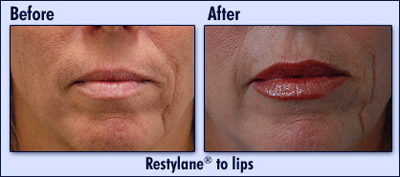Fillers: Juvederm, Restylane
Juvederm
Young, radiant and healthy skin contains a naturally formed hydrating substance called hyaluronic acid. As we age, the abundance of hyaluronic acid is reduced. This lack of hyaluronic acid causes facial skin to lose structure and volume, creating wrinkles and folds. These include wrinkles and lines around your lips and nose.
Juvederm is a safe and effective way to bring back volume and reduce the appearance of facial wrinkles by replacing the hyaluronic acid that diminishes as we age. Because Juvederm is a non-surgical procedure, you are free to return to your regular activities right after the quick treatment, and you will see the results immediately!
How Does Juvederm Work?
Juvederm is considered a non-surgical procedure, with no downtime. Your Center For Excellence In Eye Care surgeon will use a fine needle to gently ease the Juvederm under the skin to fill the soft tissue of the dermis, adding smoothness and volume to the areas that once had wrinkles or folds.
How Long Do Results Last with Juvederm?
Depending on the deepness and amount of wrinkles, Juvederm can last up to one year with just one treatment!
What Makes Juvederm Different than Other Dermal Fillers?
Juvederm is not the only filler that contains the skin’s naturally produced hyaluronic acid, but Juvederm is developed differently than the rest. Juvederm uses a manufacturing process called Hylacross technology, giving it a special smooth-gel structure that holds up over time. This allows results to last longer than other dermal fillers.
Restylane
Your skin is made of layers. Between those layers is a clear, jelly-like substance called hyaluronic acid. As you grow older, the amount of hyaluronic acid diminishes, and your skin can cave, causing a wrinkle along the line. That’s where dermal fillers come in.
In simple terms, Restylane is a clear, biodegradable filler, based on hyaluronic acid. It is injected into the skin to replace the hyaluronic acid that has dissipated over time. Restylane fills in and smoothes out wrinkles.
Restylane is for those who want to reduce or eliminate:
- Forehead lines
- Crow’s feet at the corner of the eyes
- Frown lines that run between eyebrows
- Vertical lines on the mouth
- Lines at the corner of the mouth
- Smile lines that run from the side of the nose to the corner of the mouth
- Acne scars
- Some facial scars

What to expect on procedure day:
Prior to your procedure, a topical anesthetic cream can be applied to the area to be treated. You can also choose to have a local anesthetic injection.
During treatment, Restylane is injected into the skin in tiny amounts with a very fine needle. The injected gel produces natural volume under the wrinkle, which is lifted up and smoothed out. The procedure takes about 30 minutes, leaves no marks or scars, and the results can be seen immediately.
Restylane wrinkle treatment is long-lasting but not permanent. The length of time a treatment maintains its effect depends on many factors such as your age, skin type, lifestyle and muscle activity, as well as the injection technique. Most patients choose to have a follow-up treatment four to six months after the initial treatment of wrinkles.
Realistic Expectations
Restylane is a safe product, made of hyaluronic acid, which is naturally present in the body. To date, more than a million treatments have successfully been carried out with Restylane in more than 60 countries worldwide.
Immediately after the treatment, you can expect slight redness, swelling, tenderness and an itching sensation in the treated area. This is a normal result of the injection. The discomfort is temporary and generally disappears in a few days. For lip augmentation injections, the swelling may last up to a week. During this time, the lips can look somewhat uneven. This means that the result directly after the treatment should not be regarded as the final result. If the discomfort continues or if other reactions occur, you should contact your doctor.
About 1 in 2000 patients experience reactions that can affect the surrounding tissues. Redness, tenderness and rarely acne-like formations have also been reported. These reactions have generally been described as mild to moderate with an average duration of two weeks.








